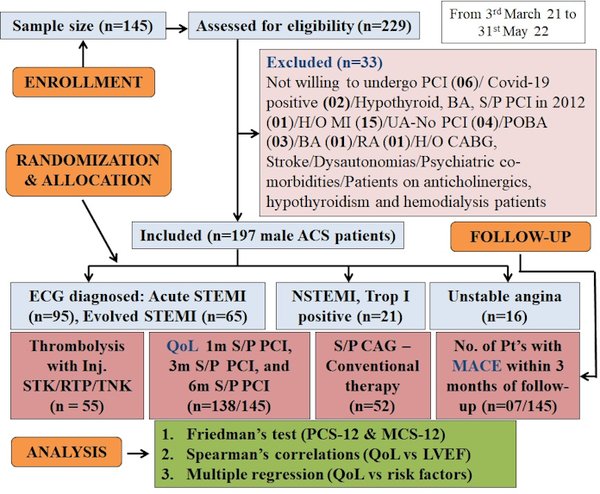-
Home
-
About JCTR
-
Gold Open Access
-
Issues
-
Editorial board
-
Author guidelines
-
Publication fees
-
Online first
-
Special issues
-
News
-
Publication ethics
-
Partners
-
Submit your manuscript
-
Submit your review report
-
Editorial Office
-

This work is licensed under a Creative Commons Attribution-NonCommercial 4.0 International License. ISSN print: 2382-6533 ISSN online: 2424-810X
Volume 9 Issue 4
Quality of life assessment in the first episode of acute coronary syndrome
Smitha Pernaje Seetharam, Vinutha Shankar*, Kaviraja Udupa, Raveesha A, Niranjan Reddy
Seetharam et al. J Clin Transl Res 2023; 9(4):23-00049
Published online: July 26, 2023
Abstract
Background: Assessment of health-related quality of life (HRQoL) is an important measure of a patient’s recovery after an illness. However, HRQoL among acute coronary syndrome (ACS) survivors has not been extensively studied following cardiac management.
Aim: The purpose of this study was to assess the QoL among ACS patients who have undergone percutaneous coronary intervention (PCI).
Methods: This cohort study included 145 consecutive male ACS patients between March 2021 and May 2022. Of these patients, 138 (mean age 54.3 ± 10.7 years) completed the QoL assessment using the short form-12 (SF-12) health survey questionnaire. Seventy (51%) of them presented with ST-segment elevation myocardial infarction, 18 (13%) had non-STEMI, 39 (28%) had evolved MI, and 11 (8%) had unstable angina. Recruited patients’ QoL data were assessed at various time points post-PCI.
Results: At the end of the 12 months of follow-up, major clinical events (MCE) defined as death, sudden death, or re-acute myocardial infarction occurred in 54.9% of patients. Out of 7 MCE, four deaths and three re-AMIs had occurred. SF-12 physical component score was found to be significantly improved when compared to the mental component score, which seems to improve without reaching statistical significance over time. Among event-free ACS patients, we found a significant positive correlation between left ventricular ejection fraction and HRQoL.
Conclusion: Improvement in HRQoL (physical component) was seen among ACS patients post-PCI.
Relevance for patients: QoL assessment outcomes should be considered in clinical settings, practice guidelines, and treatment modality post-PCI to improve QoL in post-ACS survivors.

DOI: http://dx.doi.org/10.18053/jctres.09.202304.23-00049
Author affilation
1. Department of Physiology, Sapthagiri Institute of Medical Sciences and Research Centre, Bangalore-560090, Karnataka, India
2. Department of Physiology, Sri Devaraj Urs Medical College, Sri Devaraj Urs Academy of Higher Education and Research, Tamaka, Kolar-563103, Karnataka, India
3. Department of Neurophysiology, NIMHANS, Bangalore-560029, Karnataka, India
4. Department of General Medicine, R.L Jalappa Hospital, Sri Devaraj Urs Academy of Higher Education and Research Kolar-563103, Karnataka, India
5. Department of Cardiology, R L Jalappa Hospital, Sri Devaraj Urs Academy of Higher Education and Research, Kolar-563103, Karnataka, India
*Corresponding author
Vinutha Shankar
Department of Physiology, Sri Devaraj Urs Medical College, Sri Devaraj Urs Academy of Higher Education and Research, Tamaka, Kolar-563103, Karnataka, India.
Tel: +919845065374, 08152 243003.
Fax: +91 (8152) 243008.
Email: vinutha.shankar@gmail.com
Handling editor:
Michal Heger
Department of Pharmaceutics, Utrecht University, the Netherlands
Department of Chemistry, Utrecht University, Utrecht, the Netherlands
Department of Pathology, Erasmus Medical Center, the Netherlands
Department of Pharmaceutics, Jiaxing University Medical College, Zhejiang, China

